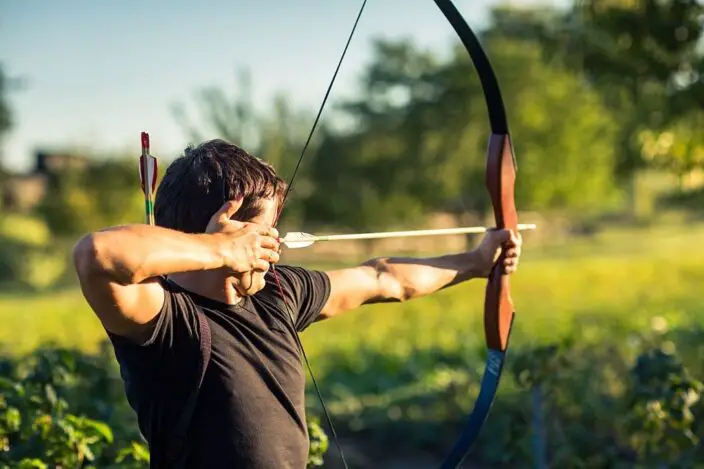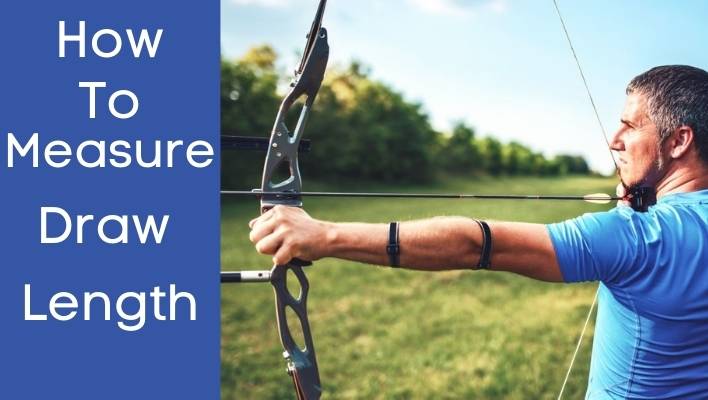In this post, I’m about to share how to measure draw length easily step by step.
For beginners, every word of this post is worth reading.
So, how to measure draw length?
- Stand upright beside a wall and stretch your arms out parallel to the ground.
- Get someone to take measurements from the tip of one mid finger to the other.
- This measurement is called wingspan.
- Divide the wingspan by 2.5
- The resulting value is your draw length.
That’s not the only way to measure draw length.
There are a lot of methods out there to do this.
By the end of this post, you will learn all of them and know the optimum draw length for you.
Table of Contents
- Explaining Draw Length
- Why Is It Important To Measure Draw Length In The First Place?
- How to measure draw length (5 easy ways)
- How to Measure Draw Length For Recurve?
- How To Measure Draw Length For Traditional Bow?
- How To Use Draw Length In Compound Bow?
- Some Useful Tips On Measuring Draw Length
- How Far Can You Draw Your Bow Safely?
- Can accurate Draw Length Boost Optimum Performance?
- Correlations between draw length and draw weight
- Why Your Bow’s Draw Length Can Change
- Draw length chart
- Recurve bow length to draw length chart
- Conclusion
Explaining Draw Length
You are here to know how to measure draw length. If not, don’t worry; I’ve dedicated a post about the nitty-gritty of draw length.
Learn the basics of draw length, arrow length, and stuff like that here- draw length vs. arrow length: What’s The Difference?
Why Is It Important To Measure Draw Length In The First Place?
An archer can’t shoot accurately if the draw length is not accurate.
- Draw length is unique from person to person. Based on your requirements, you need to find a bow that suits that specification.
- Once you’ve bought a bow, you’ve no options to change its draw length. So, always measure your draw length and choose a bow that suits it.
- Draw length is critical for an accurate shot.
- Wrong draw length can hurt you.
- When the draw length is shorter than expected, it will break the bow, and when longer, you can’t draw.
How to measure draw length (5 easy ways)
There are a couple of other ways to measure draw length. In this section, you will learn all of them step by step.
Let’s do this.
Also learn: How to determine proper arrow length
#1 Wingspan Method: Calculated Draw Length
The wingspan method is the most popular and accurate method to determine draw length—also the easiest way to go.
Here’s how to do this.
- Stand upright beside a wall and stretch your arms out parallel to the ground.
- Get someone to take measurements from the tip of one mid finger to the other.
- This measurement is called wingspan.
- Divide the wingspan by 2.5
- The resulting value is your draw length.
Pro-Tip: Calculated draw length is primarily accurate and thus used widely. But, this method involves taking measurements that lead to human error measurement issues. Consider taking measurements three times and average the result that will increase the correctness of the measures.
#2 Wingspan Method: Calculated Draw Length (Minus 15/2.5)
The measurement procedure is the same as before, but the calculation procedure is different.
So, where’s the difference?
The Simple math! There’s a slight difference.
In this method, you need to subtract 15 from the wingspan and then, have to divide it by 2.5. Although these calculations won’t bring a huge difference, some archers prefer these options as they find them more comfortable.
Let me show you how this process works through an example.
Let’s say your wingspan length is 75 cm. Now, you need to subtract 15 from it, and in this case, it will be 60 then. At this point, you need to divide the value by 2.5 as the previous method, which will bring the result to 24.
I hope you got it right!
#3 Buttons to Base
Let’s get straight about how to determine draw length this way?
- Stand upright and extend your dominant hand out to face forward with your open palm at shoulder height.
- Get someone to take measures from your sternum at the center of your chest to the wrist on the extended arm.
- The measured value will be your draw length.
Editor’s Note
This method won’t give you an accurate value if your arm length is not equal. Although, the size of the two arms is not always similar. Slight mismatches in the span of two arms are entirely natural. But, if the difference is significant enough, then this method will give you a skewed result.
#4 True Draw Length Method
41 % of archers like this method.
Grip to knock process, also known as the ATA, formerly AMO standard practice to determine draw length.
This way of measuring draw length is famous for its accuracy.
Now let me tell you how it works.
Start at the throat of your bow and figure out the furthest point that this part reaches to obtain the pivot point.
When establishing the grips pivot point, measure out to the nock point where your arrow sits. Add 1.75 inches with the measures.
The determined length would be your actual draw length for your bow.
#5 The Feign method
I’d like to say this is a feign method, and others call it differently. Whatever we call it, the technique is the same.
Another beautiful part is this method is straightforward to execute. The bad part is people are not using this method widely.
Well, how does this work?
Like its name, you need to pretend to draw a bow to take the measurements. Pretend that you are drawing an imaginary bow comfortably at a full draw position. Keep the draw and stance as natural as you can. Get someone to determine the length from the corner of your mouth to the top of your fist.
Note: The feigns draw method is a convenient technique for experienced archers but not helpful for beginners. Only advanced archers who are confident about their draw form can try this technique.
#6 From the nock groove to the back of the bow
Last but not least, this method is among the most popular ones. Almost 48,9% of people like to measure the draw length for the bow in this way.
It’s time to let you know how to measure following this method.
- Stand and take your bow.
- Pretend shooting an arrow at your full draw
- Ask someone to take measurements
- The measurement would be from the nock groove to the back of your bow.
That’s it! As simple as that.
How to Measure Draw Length For Recurve?
ATA/AMO standard method is the best way to determine draw length for recurve. Also, any other manner mentioned above will work fine.
Using AMO standard way, here is how you can measure draw length for recurve.
Take the distance measurements from the deepest part of the grip to the back of the bow. Then, add one ¾” with the measured distance. That would be your draw length for your recurve bow. Most archers find this method for measuring draw length to recurve much more accurately.
Thus, I recommend so.
Now let’s know if a recurve bow has any significant contrast with other bows to measure and use
Recurve bow is more forgiving at a wider draw length than other bows, and that’s why it has a margin of error. For instance, if the draw length for your recurve bow is 29″ and you draw with such a force that crosses the 29″ draw line, in this situation, the level of force increases, and the phenomenon is known as ‘stacking.
It means if you draw less than your draw length, it won’t be able to store enough potential energy, which otherwise could be.
How To Measure Draw Length For Traditional Bow?

Here’s the step-by-step process of measuring draw length for a traditional recurve or longbow. Often, drawing and marking are not the best way to measure draw length for a conventional bow, and this technique I regarded as the most accurate way to measure draw length.
Why?
Because most archers initially pull back as much as they can, but before release, they ease off the draw to settle into their natural state—this contradiction in reaching optimum performance.
Here I’m showing a proven formula given by Bob Lee, which is considered the best way to determine actual draw length. (Especially for traditional bow)
Step 1: Measure Arrow (Everyone Skip it)
How do you measure arrow draw length? Have you ever thought of using it to measure draw length? Yes. there’s a way to measure draw length with an arrow
How?
Measure arrow shaft length from the groove of arrow excluding broadhead.
Step 2: Employ An Assistant To Observe
Get assistance from someone to observe your draw and release.
Step 3: Count The Average
Ask the observer to focus on how much of the arrow shaft (minus the point or broadhead) remains past the shelf.
Step 4: Validate The Outcome
Double-check the result before considering the final draw length, as there’s a clear correlation between the height of archers and draw length. If your size is 5.8″ and somehow you found the last measurement as 31″, it’s an error. The average height archers (5′ 10″) will have a 28″ draw length.
Further Reading on this method: https://bobleebows.com/measure-draw-length-traditional-bow/
How To Use Draw Length In Compound Bow?
Do you know what a full draw is? The total interest is shooting from your full draw position.
What the heck do you do with this?
The compound bow is only meant to be shot from a full draw. For example, if your draw length for the compound bow is 28″, you should invariably draw back to 29″ and shoot from that position. And you should never attempt to shoot from the middle of the Powerstroke.
Why?
Otherwise, your compound bow won’t store a high amount of potential energy you can use on Powerstroke. If you are beginner archers just starting, you should encounter a question, “Well, I don’t know my full draw position.” Yes, it’s an obvious question. But, it has an obvious answer too. You can determine the full draw position by drawing back with full force until mechanical functions stop you!
Some Useful Tips On Measuring Draw Length
I’ve got you a handful of tips on measuring draw length. Hopefully, if you follow this, you can enhance your performance even more.
Let’s get started.
- Advanced Method For Measuring Draw Length
If you want to find the maximum accurate draw length, this process is for you. In this process, first, take a bow where CAM is changeable. Now shoot 300 times and see how you perform at different draw lengths. When you reach the golden circle of accuracy, count those draw lengths and take their average. If you can undergo this hard work initially, you might not have to encounter the taste of defeat.
Protip: Increment or decrement draw length by 1/4 to 1/2 inches to test the performance,
- Valuable Tips To Bear In Mind While Measuring Draw Length
- Right Posture
Whatever method you use to measure draw length, you may encounter human measurement error, most likely all of the time. Although you can’t eliminate it, you can significantly reduce this.
- Check Measurements
Measurement. Measurement. Measurement. I’m stressing it time and again as truly it affects your performance as an archer directly. If you buy a bow based on wrongly measured draw length, it’s a matter of concern. Once you buy a bow, no matter whether your previous measurement was wrong, you can’t change it.
How Far Can You Draw Your Bow Safely?
Overdrawing and underdrawing of bow can create potential health risks and performance issues. So, you want to know about the optimal length for drawing a bow.
You’ve no way to go more than your actual draw length for compound bows.
Why?
Because you’ll have no way to draw more as you will be forced back by its mechanical stop, only it’s possible to draw more than draw is by automatic modification, but it may create a potential risk of injuries. Mentionable, overdrawing in any kind of bow can cause injury.
Beware of that.
Overdrawing or underdrawing can also impact shooting performance like speed and accuracy. (You are going to know more about it in the following sections)
Can accurate Draw Length Boost Optimum Performance?
Yes, exact draw length boosts optimum performance.
Overdrawing and under-drawing have a terrible and good impact on the bow’s shooting performance. Under drawing hasn’t any effect on
The first is accuracy. Whether you’re a beginner or a pro, everyone wants to be as accurate as possible in firing a bow.
The problem: Finding the exact draw length is daunting. You can unintentionally draw from the wrong position in some cases, especially if you are a beginner. The absolute best tip I’ve at my disposal is to shoot about 300 times before playing or hunting; that way, you will be able to find your optimum draw length.
And What About Speed?
The accuracy and forgiveness of an arrow depend on its speed, and that’s why speed is crucial for an archer’s success.
And since draw length affects speed, it’s a matter of concern.
Since draw length affects arrow speed, it’s crucial to maintain proper draw length.
Generally speaking, the longer the draw length, the higher the arrow speed would be.
Do you know that 1″ of draw length can contribute about ten fps of arrow velocity! But, most archers falsely estimate this and draw either less or more than the appropriate draw length.
If you want more speed and accuracy, you mustn’t mess up draw length, and the best tip I’ve for you to find optimum draw length is to shoot at least 300 times before the actual game.
Correlations between draw length and draw weight
Simply put, draw weight has a relationship with draw length.
How?
To understand, you must know what draw weight is. Draw weight is the force needed to draw the bow back to its entire length.
Relatable?
Yes, the higher weight you put in to pull back your draw, the higher your draw length would be.
That said, the draw weight has a clear correlation with the draw weight.
Why Your Bow’s Draw Length Can Change
Here are a few reasons why your draw length might change over the period.
- If you are young now, the draw length might change slightly at some point in your life.
- Draw length might vary from brand to brand.
- It may even vary from bows to bows.
- If you adjust your bow’s draw length, the draw length will change. six
Draw length chart
| Arm Span (inches) | Draw Length (inches) |
|---|---|
| 60 | 24 |
| 62.5 | 25 |
| 65 | 26 |
| 67 | 27 |
| 70 | 28 |
| 72.5 | 29 |
| 75 | 30 |
| 77.5 | 31 |
Recurve bow length to draw length chart
| Recurve Bow Length (inches) | Draw Length (inches) |
|---|---|
| 14-16 | 48 |
| 17-20 | 54 |
| 20-22 | 58 |
| 22-24 | 62 |
| 24-26 | 64-66 |
| 26-28 | 66-68 |
| 28-30 | 68-70 |
| 31+ | 70-72 |
Conclusion
I showed you six ways to measure draw length for your bow at home. I also told you why draw length is significant and how to use it properly to gain optimum performance.
Besides, I gave you some tips regarding draw length.
There left no doubt that draw length is crucial for archers’ and hunters’ performance. The best way to attain a perfect draw length that fires an accurate shot and lets the arrow fly like mad is to shoot as much as possible!
If you find a hard time following all the steps above you might use a draw length calculator.
I’m drawing the end here. If anything confused you or gave you some value, I request you to leave a comment below.

